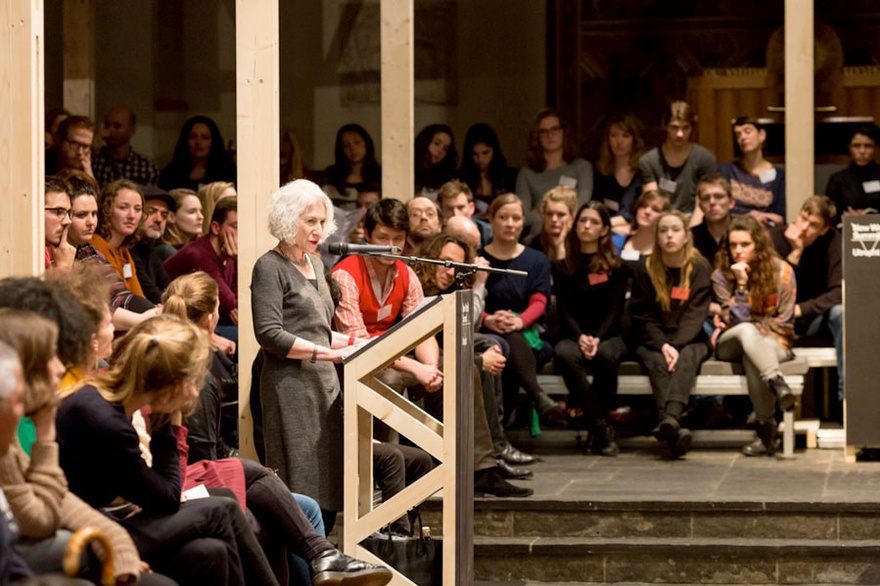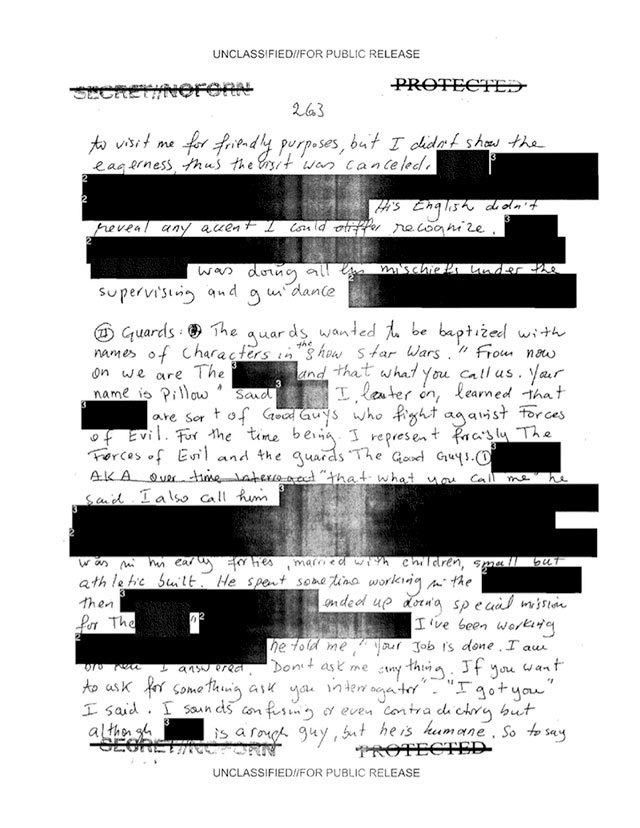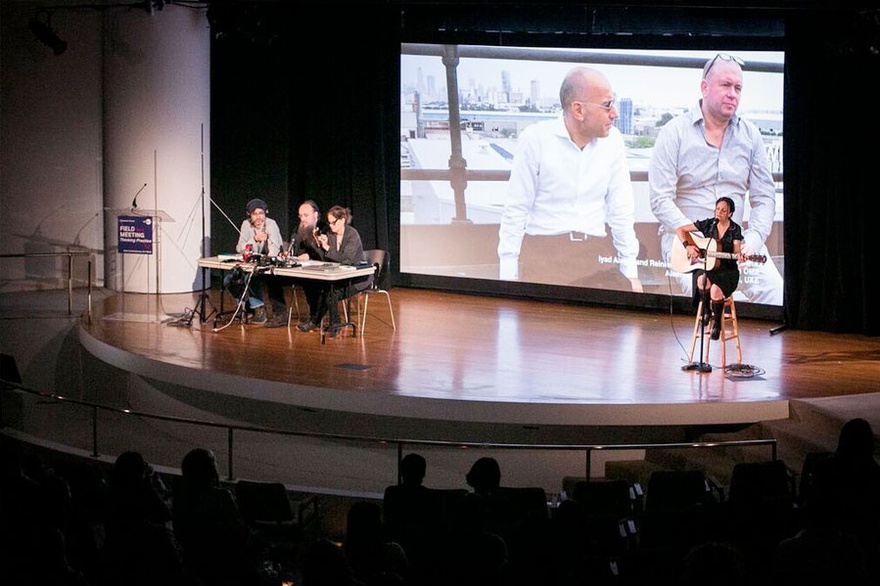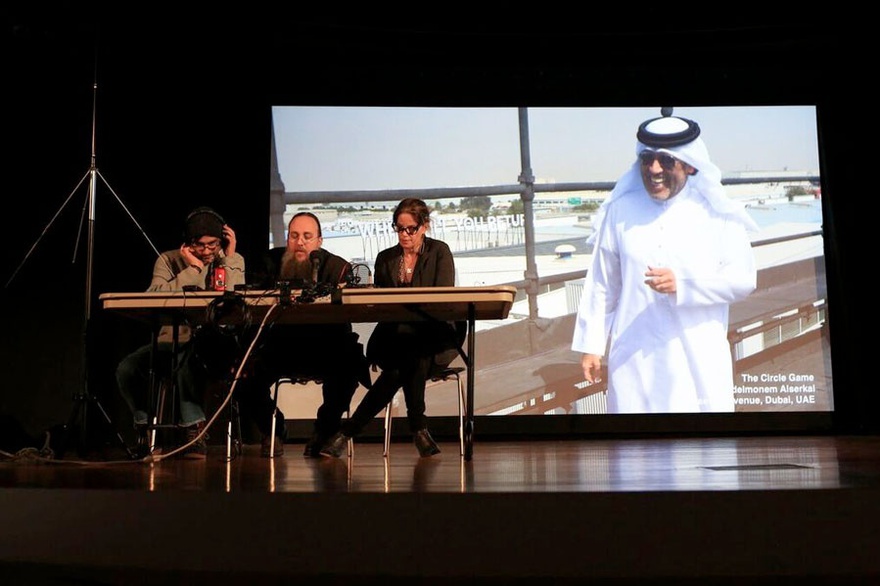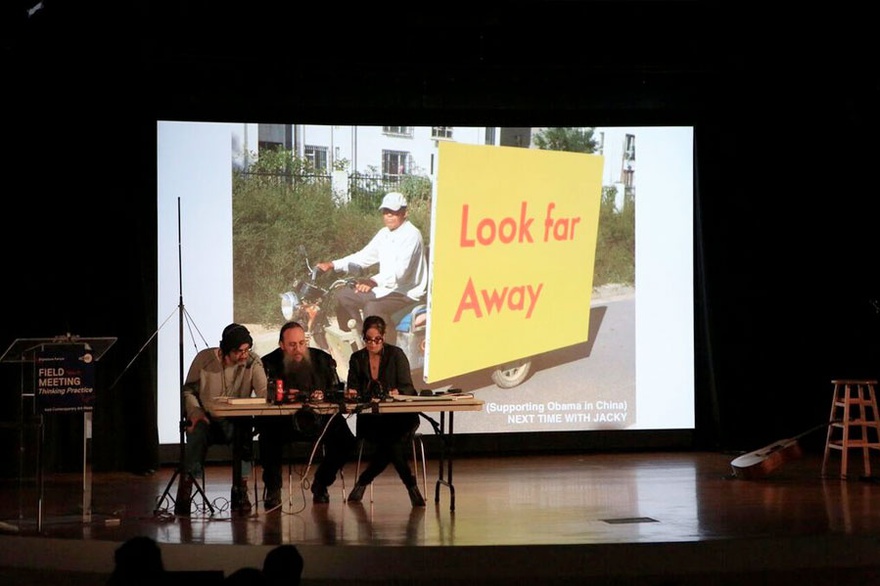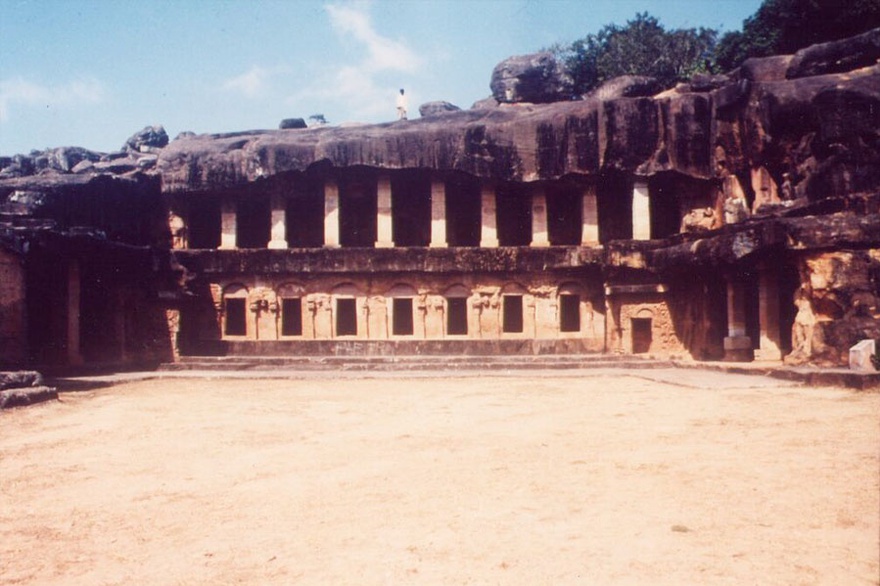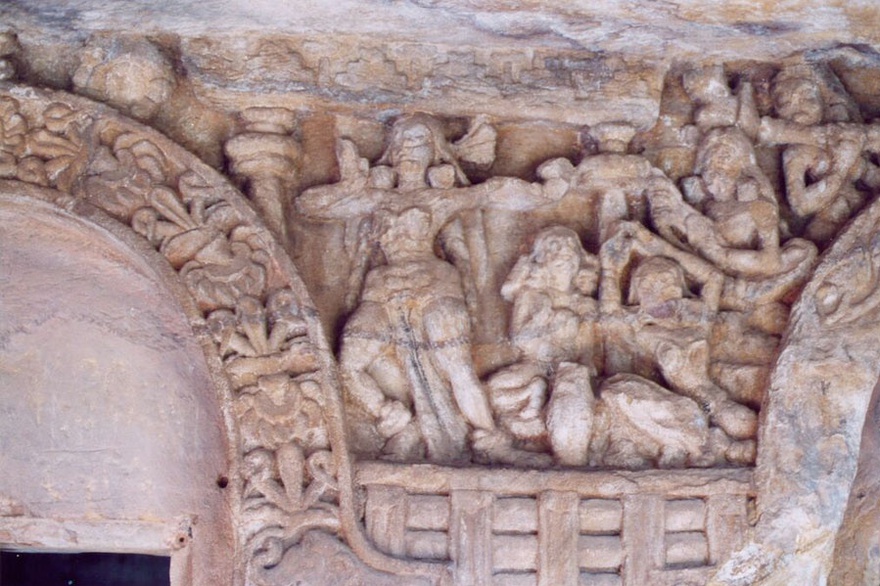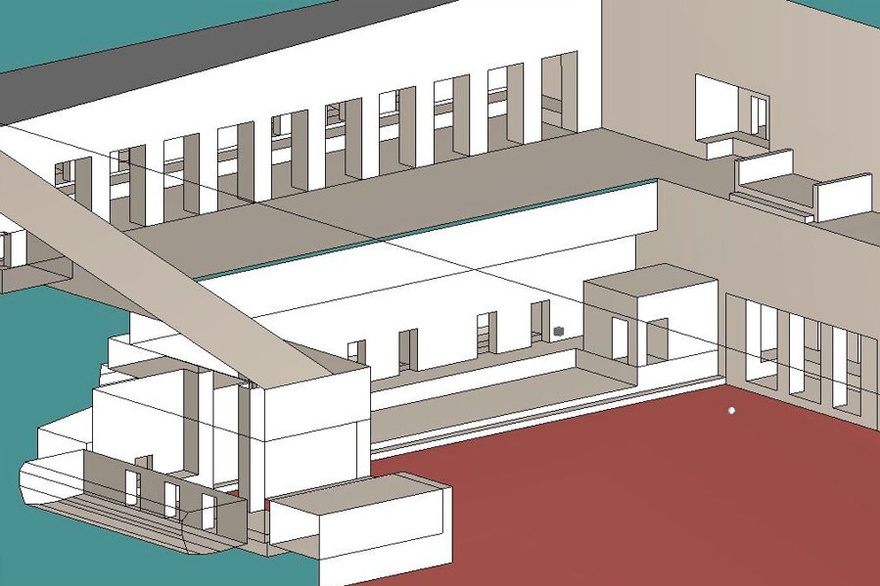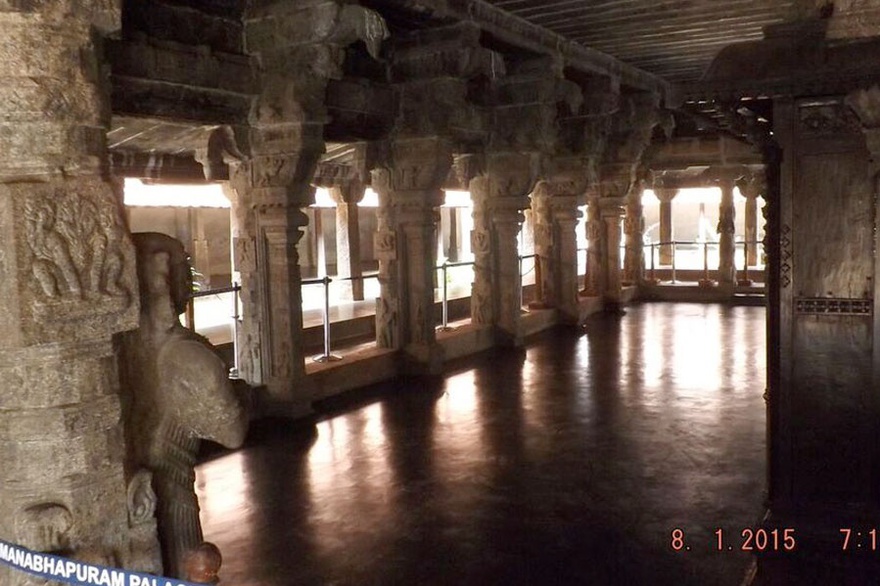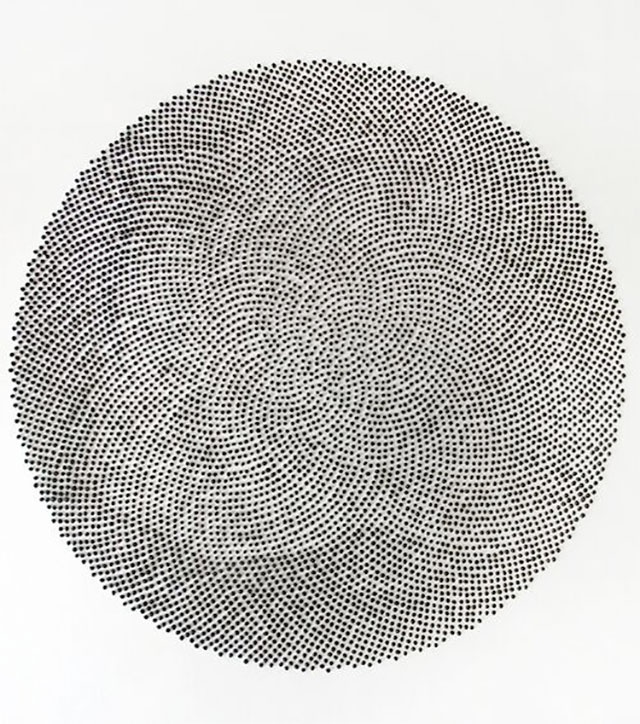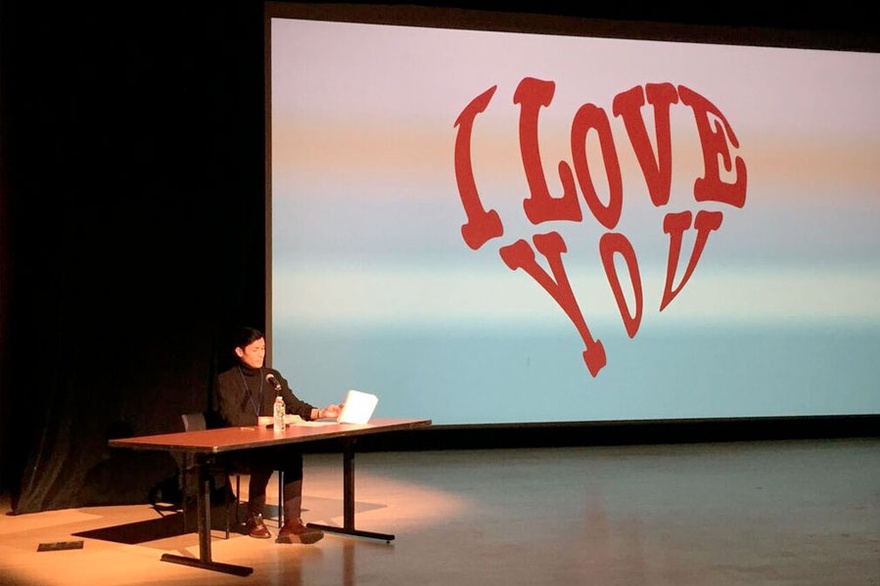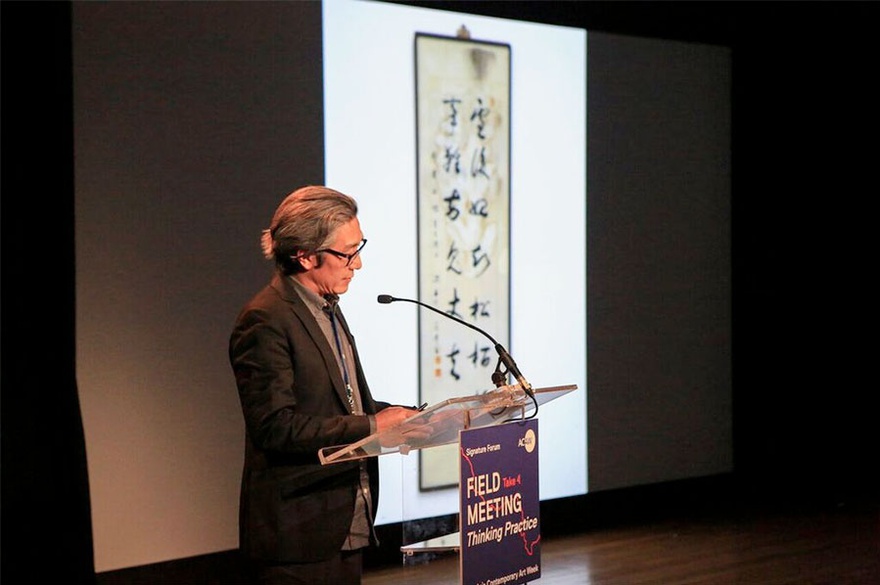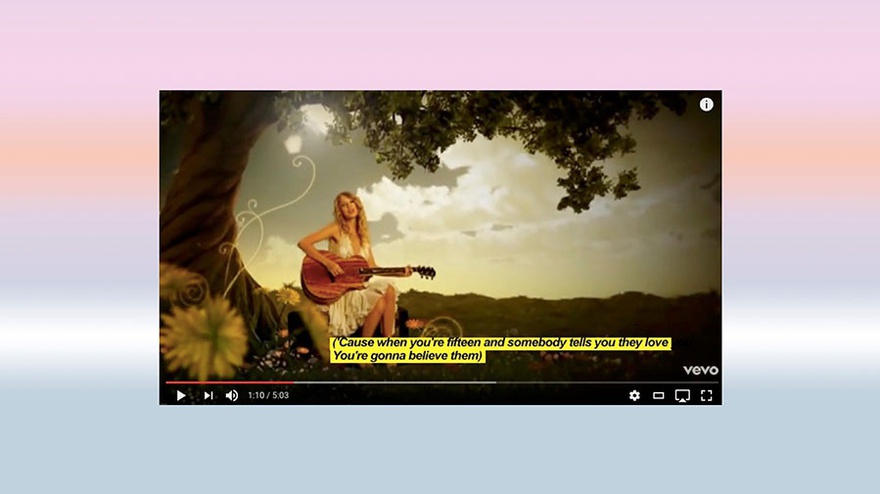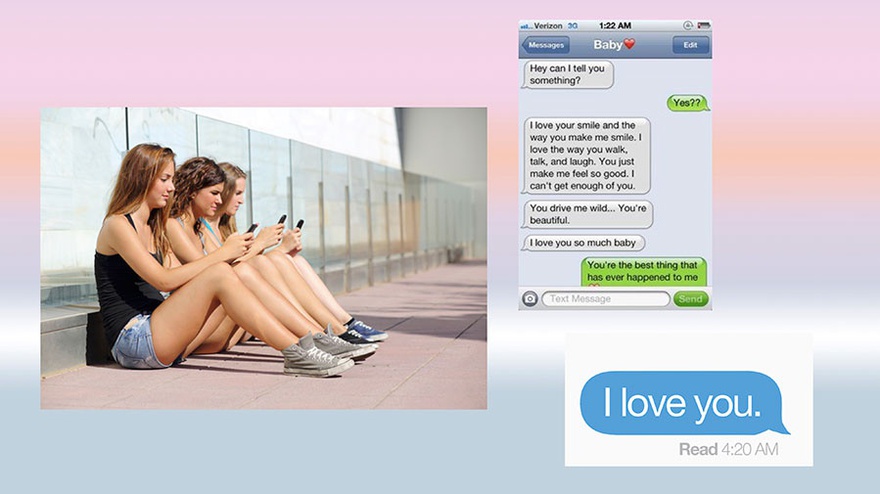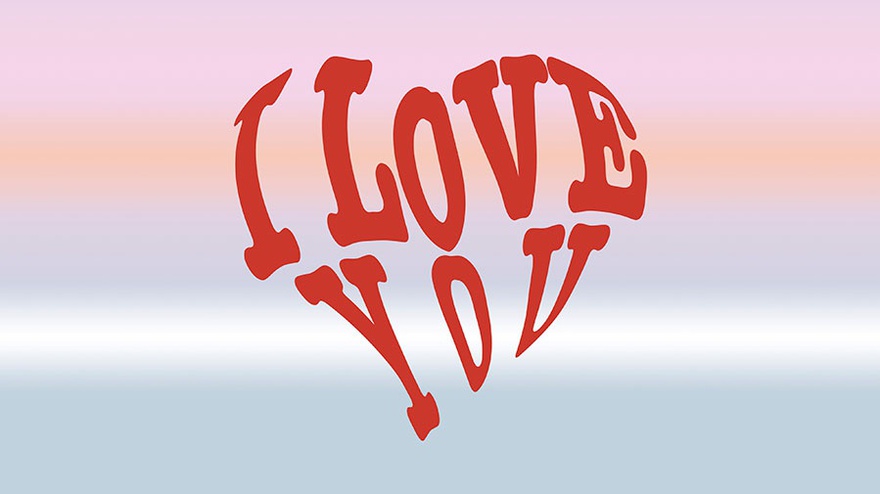Publications
FIELD MEETING Take 4: Thinking Practice
Responses
Contents: Click on the names below to visit each artist's section
Presenters: Jennifer Wen Ma, Jonas Staal, Mary Ellen Carroll, Mithu Sen, Umashankar Manthravadi, Xyza Cruz Bacani, Ye Funa.
Respondents: Arahmaiani and Yasmin Jahan Nupur, Beatrice Glow, Robert Lee, Beth Citron, Christopher K. Ho, Anila Quayyum Agha.
The Alchemy of Making Paradise Interrupted: A Visual Report
When thinking about how to discuss creating the installation opera Paradise Interrupted, I decided to make a performance showing the mysterious, non-linear, and alchemistic creative process behind its making.
I asked performance artist Ron Pierre Jean-Gilles, and Guillermo Acevedo, my interactive technology director from the opera, to be onstage and act out the various 'voices' in my head throughout the creative process. Guillermo was the technological arm, providing images, voice effects, music, and video. Ron was the embodiment of the different inspirations and influences, adding some of his own as a part of course.
The piece culminated with Ron, who is Haitian, conducting a voodoo ceremony channeling loa Papa Legba, asking him to open the gate that allows the flow of communication and inspiration between this and the 'other' world. The roaring Underground Horns, a five-piece marching band, then joined Ron on stage.
Madeline Ludwig-Leone, from my studio, and I also stepped up on stage to open the paper sculpture garden, assisted Ron with donning a Chinese opera warrior headdress and flag costume changes and joined the parade in the end with pom-poms and confetti.
The whole process was messy and imperfect, exhilarating and filled with possibilities. A few things didn't work, and some did. I enjoyed seeing the onstage performance release a different and improvisational type of energy, breaking down the barriers between performer, collaborators, director, crew and audience. It is opposite of the tightly rehearsed and metered cadence of the opera. I'm grateful for ACAW FIELD MEETING and Leeza Ahmady's invitation to present The Alchemy of Making Paradise Interrupted. It is only the start of a new exploration, and we look forward to future working opportunities to play and make.
A bodiless voice echoed through the auditorium on Day 1 of FIELD MEETING: Thinking Practice as the founder of New World Summit, Jonas Staal, performed his absence through a recorded lecture-performance, as a result of his visa suspension. In the following short essay, Staal further elaborates on the concepts he presented on during the forum.
Performing Absence
(fragment)
In her post-September 11 writings, philosopher Judith Butler wrote about the importance to 'hear beyond what we're able to hear'. Hearing beyond what we're able to hear in this case means to challenge the Us/Them dichotomy, which forms the underlying ideological doctrine of the now fifteen-year-old War on Terror.
The War on Terror is a neocolonial war that finds its legitimacy by claiming the right of what is constructed as 'Us' to dictate the world to those that are constructed as 'Them'. Them, in this case, is the 'Other', the terrorist. Hearing beyond what we're able to hear, as Butler phrased it, thus means to challenge who is 'Us' in the Us/Them dichotomy. And it often means that individuals that once lived the privileged and protected sphere of being part of 'Us' are forced into becoming Them: progressive journalists, activists, public intellectuals… Many have experienced what it means to be labeled a 'traitor', to become a so-called terrorist by association. They must learn to perform their absence from the existing political order permanently.
Lawyer Nancy Hollander described this brilliantly in a 2010 New York Times op-ed entitled 'A Terrorist Lawyer, and Proud of it'. She writes how through her lifetime she had defended people accused of all sorts of criminal action, from fraudulent behavior to murder, but that from the moment that she defended suspects of so-called terrorist activities, suddenly she herself was accused of being a terrorist as well. And she responded defiantly, by saying that if defending the law as it was before September 11 was to be considered a terrorist act, then she would proudly claim the title of "terrorist lawyer." In other words, in order to redefine the concept of 'Us' as an inclusive concept, Hollander was forced to become 'Them' first.
One of Hollander's clients, the Mauritanian citizen Mohamedou Ould Slahi, gave true testimony to what it means to perform absence through his work Guantánamo Diary. Ould Slahi was a prisoner in Guantánamo Bay for fifteen years, where he remained without being formally charged, and where he was exposed to brutal torture and abuse. Ould Slahi described his experiences in his writings, which takes the form of a diary which simultaneously forms a brilliant reflection on and critique of the neocolonial character of the War on Terror. But his writings were only released after years of legal struggle, and only in a heavily redacted way. The redactions were included in the final publication. Half of Ould Slahi's words had become absent.
Ould Slahi's writing was countered by a different writing: a brutal, anonymous and abstract writing, formed by the black squares covering Ould Slahi's words. A collective writing, of what could be the hand of many different censors, without any of them claiming personal responsibility of what they had forced into absence. But some squares revealed their particular vile signature even more than others: for example, in a moment when Ould Slahi recalls a conversation with one of his guards. I quote:
No worry, you gonna go back to your family," he said. When he said that I couldn't help breaking in ■■■■■.
As Larry Siems, Ould Slahi's editor notes, it's hard to believe that the United States government censored the word 'tears' in the name of national security. The idea that a human emotion that gives evidence to the fact one is present – that an imprisoned human remains a human – would need to be forced into absence. Through his writing, and by including its redactions, Ould Slahi – who only a few weeks ago was finally released from Guantánamo Bay – turned the performance of absence into an important and urgent existential art.
Maybe art in this regard is not about representation primarily. Maybe art shows us just as much what it means to recognize absence, in order to make a new present a reality for all of us.
To Stop the War(s)
Upon the completion of the writing of this text on December 12, 2016, it was announced that Aleppo may 'fall under the government's complete control,' and there is 'the complete meltdown of humanity'. Syria has been described as the greatest humanitarian crisis of our time.
The following is an excerpt from an interview that Mary Ellen Carroll conducted with the Berlin-based exiled Syrian playwright Mohammed Al Attar. The interview began in August 2015 at the Civitella Ranieri Foundation, in Umbertide, Italy, and was completed at the American Academy in Berlin in July 2016. It will be published in its entirety, early in 2017. The session was staged as a live radio program during Asia Contemporary Art Week (ACAW)'s signature forum, FIELD MEETING Take 4: Thinking Practice, on November 11, 2016, hosted at the Guggenheim Museum, and was broadcasted over the radio frequency, 87.9 FM. Mary Ellen Carroll's participation in FIELD MEETING was supported by Alserkal Avenue (Dubai).
The program began with the interview with Al Attar. Mary Ellen was then joined onstage for rest of the broadcast with the producer/impresario – Kennan Gudjonsson and the journalist, writer, producer and comic – Saman Arbabi. Acclaimed singer/songwriter Nina Nastasia was invited earlier this summer to write and compose a song in response to the interview with Al Attar and the war(s) in Syria and elsewhere. It was performed during the lecture, To Stop the War(s) at Robert Wilson's Watermill Center on August 18, 2016. Nastasia appeared live before the audience at ACAW's FIELD MEETING: Thinking Practice and performed the song as an interstitial in the presentation, to emphasize the process of amplification and translation to make these humanitarian crises audible. This was the New York City premiere. There was also a discussion of using policy as a material and the works: prototype 180, PUBLIC UTILITY 2.0., and The Circle Game were included in this discussion.
Mary Ellen Carroll: The Syrian middle class and its demise is a subject you have raised on numerous occasions – from the description of your own childhood in a Damascus suburb to the influence on your work of the Egyptian filmmaker Mohamed Hamed Hassan Khan. You discussed how the middle class is a stabilizing factor in both politics and the economy. It is also checks and balances the ruling elite, while also providing an aspiration for the less fortunate. The obliteration of the Syrian middle class has accelerated the destruction of infrastructure and basic resources for everyone in the country, which is now, as you've said, at its breaking point – if not already beyond.
That evidence is in the numbers: in 2011, the pre-war population of Syria was over 23 million people. Since the start of the war, on March 15, 2011, over 4.8 million people have been registered as refugees, per the UN's most current statistics, and over 250,000 people have been killed, half of which are civilians. The media frames this as people who have lost their lives, but their lives have been taken.
Mohammad Al Attar: Let me begin with the media and the numbers, as the international media is, in fact, missing numbers; they are actually much higher. We don't know the exact figure because a significant number of people are missing. The majority of them are being detained by the Assad regime, and there are others detained by the Islamic State and other paramilitary troops. But the majority are being detained by the regime, and we do not know if they are even alive. We do not have accurate numbers or even a way to ascertain if they are living. The number circulated by human rights organizations and even by underground Syrian activists both agree that the numbers are higher than those declared.
Carroll: Those numbers are facts, and in 2013 you did an interview with Noam Chomsky in which you asked him if he now had advice for the situation in Syria. He said that he had no advice, except to say, 'You have to face the actual facts and not stay in a world of your own imagining, saying "I want this" and "I don't want that".' In interviews about your own writing and Syria you have been asked the question about what the Syrians want. Given the concessions that need to be made, what do you imagine the end to be and how do you see this happening? What do you want within the realm of the real?
Al Attar: To stop the war.
The following are the lyrics that Nina Nastasia wrote and the song she performed for the live radio program that was staged for ACAW's FIELD MEETING Take 4: Thinking Practice at the Solomon R. Guggenheim Museum in New York City on Friday, November 11, 2016.
I have lost them
my neighbor
my sister
my son
Blood flows downriver
out into nothing
slow to deliver
anyone
We bury the past, but there is an ember
beneath the dry grass of all I remember
Old bone snapping
grown men laughing
young skin tearing
The face that I show is a fearful and forbidden one
that you need to know; the one you wear is painted on
What is under there
Is it fear
Fear of losing the peace
Fear of losing your nerve
of getting what you deserve
A minimum of justice must be served
So I come from near by to your home, to your table
No eye for an eye
but to bare the truth
Nina Nastasia © 2016
Performing APHASIA
FIELD MEETING gave me the opportunity to present my views, beliefs, thought process at a brilliant platform with a reach of a wide audience. I am really glad that a lot of people understood the intent behind my performances.
The idea was to challenge the given conduct of things that conveniently pass as 'normal'. My debate starts from the blind acceptance of the rules that we create as a society. The idea might have sounded absurd to many people, but to create a language that has no barriers, a way of communicating beyond what's comfortable has been the core of my practice for quite some time. It also made people experience the feeling of controlled power and its politics, the feeling of being dominated and suppressed by others. I tried to make each person in the audience go through the stretch of 'thinking practice' methods through an alternate route of my non-language by breaking the whole presentation in two parts, delivered on two different days at two different venues.
I would like to extend my heartfelt thanks to ACAW FIELD MEETING organizational team and FIELD MEETING curator Leeza Ahmady for her brave acceptance of my proposal and concept. The performances would not have been possible without the support of the team, who at every point gave me insightful feedback and understood that my appropriation of the email exchanges and guidelines throughout the performance was indeed a metaphor for explaining the process. Most boldly, they accepted my continuation of using non-language speech in answer to the moderators during the discussion session, which turned the panel into a non-scripted organic performance by the moderators and other artists themselves.
The Earcheologist & His Manmade Cave
On Day 2 of FIELD MEETING: Thinking Practice at Asia Society, Umashankar Manthravadi – audio hobbyist, professional sound recordist, and consultant to an ethnomusicology archive – presented on his 23-year quest to decode the acoustic properties of Ranigumpha, an elaborate man-made structure from 3rd century BCE in the Khandagiri Mountains of India. Using software he developed, Mantravadi sought to prove the ancient structure was once used as a theater.
Demonstrating how his build microphone works, Manthravadi illustrated how the acoustics of a space can measured and visualized. His hope is that the system of measurements he has created will one day be accessible to everybody, to enable a sound archive that may catalogue the acoustics of various spaces. Manthravadi wrote the following essay as an extension of his lecture and to further contextualize his life-long esoteric practice of what he calls 'Earcheology'.
Think of acoustic measurements as snapshots, or blue prints, without people in them: musical instruments that are not being played anymore, because we forgot the music. These are places where performances took place, though we no longer know what kind of performances they were.
The measurements themselves are small and easily stored; they can be used to create virtual acoustic spaces. Making the measurements was once difficult and expensive, but my work over the last decade has been to make this process easier, and importantly, inexpensive.
I will begin at the beginning. Actors in ancient India formed groups called Bharatas (and competing groups called Silalins) and the earliest theatre text we have is called Natya Sastra (from the 5th to 3rd centuries BCE) written by 'Bharata'.
In this we are told:
When gods asked Bharatas to perform a play, they chose Amrit Manthan – Churning of the Ocean of Milk. But when they started, the losers in that event, the asuras, were enraged. They started throwing stones, blood and fire on the stage and the audience. (They were the losers: they were cheated of the nectar of immortality, the 'amrit'.)
Brahma, the creator, then intervened and told the actors to take the performance indoors. He gave them detailed instructions on the size and dimensions of the stage and the theatre. (Introductory chapter of Bharata Sastra)
In 1994, I was asked by a theatre arts professor (Professor Tom Ault of Indiana University of Pennsylvania) to measure the acoustic properties of Ranigumpha, a man-made cave near Bhubaneswar, Orissa. He asked me to establish that it was a theatre. I warned him that any measurements of mine were unlikely to convince the Archaeological Survey of India – which did not think it was a theatre – but went ahead anyway.
I have been a sound recordist and technician protecting a very large ethnomusicology archive in India for many years, but had till that point not thought seriously about acoustics.
My arrival at Ranigumpha opened my mind (and my ears) to an entirely new world.
There is the audacity of the structure. Imagine a mountaintop, half of it removed to provide space for an audience of over a thousand, and the other half carved out into a two-storey theatre. That is Ranigumpha. Very elaborately carved – there are no ritual images, but plenty of beautifully carved elephants. There is narrative series of carvings at the back. It is also very old; it could be as old as 3rd century BCE.
As you step off the stone path into the amphitheatre, the acoustics changes into that of a well-designed auditorium. And you notice other details. There is large amount of amplification of the voice, but only when on the stage. Speaking in the audience space the sound is normal, as it would be in any open space.
I had, I thought, two problems to solve. The first was – what kind of measurements would convince others, even if only other acousticians, about the wonderful acoustics of this space? And second, what elements of this structure created this acoustic effect?
In my first visit, I rented an extremely boomy loudspeaker from a local provider of loud music for weddings, and I took my 486 desktop with a 540 mb hard disk. We also rented a computer monitor. I tried clicks and pre-recorded tones at various frequencies. I ran out of hard disk space in one night and came back home.
Online, I discovered Angelo Farina, professor in engineering acoustics at the University of Parma, who created software called Aurora, which generates the test waveforms and analyses the results to meet the current standards for such measurements. After some discussion, Angelo provided the software free (it used to cost about 500 US dollars).
I felt the second question could be answered by an acoustic modelling programme. These had been designed to aid architects building auditoriums.
To build this model, we required precise architectural drawings. The Archaeological Survey of India produces very detailed drawings of almost all the sites in India, but then you discover they are not exactly precise. Ranigumpha's floors and rear walls are curved. One fixed curvature for the back of the lower row of rooms, and another curvature for the upper rooms. And while these curvatures matter for the acoustic properties of the space, ASI had straightened them out – I don't remember the exact words, but their report says the errors due to 'bad workmanship' have been ignored. This meant that we took a plumb bob, measuring tape and paper, and spent a week measuring every element of the structure. Then I spent six months building the computer model.
What did the model do? By removing the rear chambers in the model, it was possible to see what contribution they made to the overall sound. They functioned like tuned reverberation chambers, amplifying the sound on stage – the reverb that normally is produced by an enclosed theatre. The curved floors and rear walls, too, contribute to the overall sound.
By this time, the questions I was asking began to change. How was a structure like Ranigumpha possible? What acoustic sensibilities were involved? And what was the environment that created these sensibilities? How has it changed over the centuries till the modern era, with its noises, ended it all?
What is needed is precise acoustic measurements of many places where performance plays a role. Places like Ranigumpha and Sita Benga – very early, acoustically important – or the theatre at Nagarjunakonda, with its explicit Greek connections, or more modern, but still old spaces like the Krishna Temple in Trivandrum, with its unbroken tradition of Sanskrit theatre performance. Some of the 'thousand pillared' halls adjacent to temples.
These structures need not be formally identified as theatres. As I said before, the Archaeological Survey of India has not identified any structure in India as a theatre: this despite the fact that India does have an old and respected performance tradition, with references going back to Kama Sutra.
The technology and the software used have developed in these 15 years and we can now record acoustic measurements as Impulse Responses, which contain all the acoustic information needed. These Impulse Responses can also be used to recreate the acoustic experience of these spaces. What was needed was a low-cost ambisonic microphone, which records the test signals on four channels. The technology was there, but very expensive.
Over the last seven or eight years, I have worked on building a low cost ambisonic microphone. 3D printing, free open source software, and technical support from many academics around the world made it possible to build the low-cost Brahma microphone.
I called it Brahma because, like the Hindu God who taught Bharata how to build a theatre, it has four heads. The four microphone capsules are made in China. In a small-scale operation near Delhi, we find four closely matched capsules and assemble them into a tetrahedron. Accurately made tetrahedral frames were not easy or cheap till the era of 3D printing. They are now printed in strong nylon.
The rest of the structure is made in the small factory near Delhi. The important part is calibrating the microphone. Much of the mathematics, and software expression of it, was developed at the University of Parma for use with Brahma microphone.
The Brahma microphone is already here. I have also built a prototype battery powered loudspeaker – a dodecahedron – to use with it. What we need to design is a kit, which includes the microphone, a four channel digital recorder, the loudspeaker and its power source, all built into a rugged suitcase that will clear airport securities around the country. Then we are off to do measurements! We will hopefully use these measurements to create virtual spaces with eight or 16 loudspeakers so you too can hear what we did.
This was the concept we described during a presentation at Art Dubai last year. Since then, the three of us, Nida Ghouse, Lawrence Abu Hamdan and I, have received a two-year, Rs 4 lakh grant from the India Foundation for the Arts, supported by Titan, to continue the process of measuring and analysing acoustically interesting spaces in India. We will be beginning the process immediately after a return to India.
Since my presentation in Dubai, one major development that has taken place is the use of ambisonic recordings in Virtual Reality along with VR cameras. The study of acoustics of these spaces is incomplete without a way of sharing it and virtual reality might be just that missing element.
Filipina street and documentary photographer Xyza Cruz Bacani's work raises awareness around the underreported stories of migrants workers and human rights issues in Hong Kong. Taking part in the panel, A Lens into the Lives and Dreams of Immigrant Workers, alongside curator Xiaoyu Weng and artist Chia-En Jao on Day 1 of FIELD MEETING: Thinking Practice at the Guggenheim, Xyza discussed her own experience as a domestic laborer and presented a selection of her black and white photographs. In revealing the story behind each image, Xyza acknowledged the full and nuanced experiences of each of her subjects, revealing them to be much more than victims of their circumstances. Xyza's video, a compilation of still photographs accompanied by a dramatic soundtrack, underlines the daily struggle of these workers' existence.
Curated Nails: Call For Proposals
In her lecture-performance on Day 2 of FIELD MEETING: Thinking Practice, artist Ye Funa, known for her satirization of propaganda and pastiche of ideological systems, proposed finger nails as a viable venue for curatorial work and nail painting as a legitimate medium for artistic activity in an effort to challenge and to de-mystify institutional authority. As the founder of 'Curated Nails,' Funa presents the following open call, inviting curators to submit exhibition proposals for the project:
Arahmaiani and Yasmin Jahan Nupur
Yasmin Jahan Nupur's performance Our Own Private Anthology involved Nupur making and kneading dough for roti, occasionally interrupting her process with subtle questions and observations towards the audience about inherited gender roles and the labor of women in patriarchal society. The work acted in quiet resistance against the social norms that entrap women, while acknowledging the tenderness in their work.
After witnessing this performance on Day 2 of FIELD MEETING: Thinking Practice at Asia Society, Arahmaiani, one of Indonesia's most iconic artists, felt compelled to respond. Arahmaiani's multi-faceted practice incorporates radical performance to relentlessly probe socio-political issues of gender, discrimination, violence, spirituality, and ecology. Inspired by the open-ended inquiries posed by Yasmin, she conceived two special paintings, which pose similar existential but very personal questions about her womanhood and hopes for the future.
Beatrice Glow: Amina Ahmed's Dhikr
This has been my fourth ACAW FIELD MEETING experience and I find it to be one of my annual art world highlights because it is a concentrated dose of stimulating artist talks, lecture performances and meeting of minds. The diverse range ACAW packs into 48-hours destabilizes any singular notion of 'Asian,' a racial construct that often goes unchallenged in Asian/Americas where the script for Asians are flattened to that of immigrants from the 'East.' In fact, there are no Asians in Asia until they leave Asia. There are majority and minority dynamics, but there is less of a notion of regional unity. In Asia, there are light and dark skin tones, but the same skin tones only become brown and yellow when these bodies travel beyond a certain geographic region. ACAW checks in with New York's cosmopolitan complacency with conversations that unravel the world's layered multiplicities. ACAW shakes up and refreshes hackneyed identitarian-based rhetorics.
What I walked away with from the marathon of conversations was feeling deeply moved by artist Amina Ahmed's talk, (but I suspect many would agree to call the experience a prayer), thus I dedicate the next few lines to Ahmed's work. In light of current political and environmental climate changes, Ahmed's words anchor us. Her drawings are active meditations on the infinitely beautiful geometric forms that shape our world. She grounded us in a simple, yet fundamental question of 'What is the most beautiful form?' She then proposed the triangle, the square, and although 'the circle is beautiful but it is the dot that makes up the circle that is the most beautiful.' This resonated deeply with me given my current work is thinking through how to transition from egosystems to ecosystems through land-based perspectives and intersectional solidarity. Her work crystallizes what it means to be part of an ecosystem by, no pun intended, making us see the bigger picture. She stated that 'contemporary art excludes spiritual practice,' yet in a museum auditorium she brought us to her quiet, yet resolute space, where each act is 'an act of remembering' that we are part of an ecosystem and each one of us are agents of change that activate each other's intellect, creativity and faith. We need more artists like her whose 'aesthetic practice transcends biological attachment to the self' in an evermore divisive and solipsistic milieu.
Beatrice Glow, 2016–2017 Artist in Residence at Asia/Pacific/American Institute at NYU and a presenter in Asia Contemporary Art Week 2014's FIELD MEETING Take 1: Critical of the Future, is an interdisciplinary artist whose work uncovers invisible, suppressed stories that lie in the geopolitical shadows of colonialism and migration.
Asian American Art and FIELD MEETING
How about contemporary Asian American art? Is there a connection to FIELD MEETING? Perhaps Yun Gee in 1925 could be said to be the first 'Asian American' artist, though this term did not come about until the early 1970s. What I can remember is that AAAC (Asian American Arts Centre) did not start exhibiting such artists regularly until 1983 and calling them Asian American. This term was contested and in some circles still is.
The IBM Gallery of Science and Art exhibited Tokyo: Form & Spirit in December 1986, however contemporary Asian art did not become hot until after Asia/America: Identities in Contemporary Asian American Art when with this show Asia Society jumped into the contemporary field. Many galleries sought Chinese contemporary artists, and art magazines claimed this as the next wave. Although many areas of Asia had developed contemporary art it was not brought to the public's attention in the US until this time. Suddenly for the American public Asia had transformed from traditional to modern. Han Art Gallery in Hong Kong had come out with their survey of China's new art post Tiananmen Square around this time, but this exhibition did not tour in the US until much later.
In 1998 Gao Minglu curated Inside Out: New Chinese Art. Of these about sixteen of the artists were Asian American, however they were viewed as overseas Chinese 'grappling with what it means to be Chinese in an age of economic globalization...'
With several artists like Jennifer Wen Ma, Christopher Ho, Michael Joo, Beatrice Glow, Patty Chang, Aki Sasamoto, and others participating in ACAW FIELD MEETING, Asian American art has come into its proper international context, reflecting its Asian diversity in America and its Diaspora, and a brilliant array of creative work, with questions composing a discourse across borders, promising to encompass the inventive and profound, an openness that will be important for many years to come.
In terms of field meeting, I would say yes, we do need to muse about the world. After all, if we don't do it, who is going to do it for us? If only for ourselves, we may not have any practical means to implement, but minimally we need to keep ourselves viable, in touch, setting our own terms and language. Imagining. So as we muse about our Asian traditions, surgically intervening in the contemporary problematique, we find philosophically, socially, politically, linguistically, artistically, historically, imagined solutions arise that seem to us self-evident. Take for example one Asian American artist, Christopher Ho, who presented a lecture-performance entitled Present Elsewhere on Day 2 of FIELD MEETING at Asia Society (November 12th). The piece was Christopher's interpretation of a project that artist Rashid Rana had proposed for Thinking Practice.
Perhaps if you were present, you heard Christopher say, at Slide 34: Defiance vs Compassion, 'What if neither Satan's defiance nor Christ's compassion begets contemporary art? What if the model is Saint Joseph, a consummate adult who willingly takes responsibility as Jesus' foster father? Joseph exhibits such adult characteristics as consistent work over bursts of genius; modesty over self-aggrandizement; discipline over self-indulgence; and sacrifice over solipsism. What art would a practice modeled on Joseph, rather than Satan or Christ yield?'
He then goes on to discuss what legacy-leaving in art would entail. First, a broad examination of Chinese state capitalism as paternal, in contrast to North American neo-liberal capitalism. '…the legacy-leaving I propose is synthetic and unabashed in its ambition to become the institution. It is dynastic, not subversive.' Does this not sound like Parag Khanna's Waving Goodbye to Hegemony?[1]
In response to Christopher, I would ask him to listen to Krista Tippett's On Being program, where she interviews Abigail Washburn who plays a mean Banjo and talks about how, before going to China to study law, she undertook the challenge to sit still and meditate. After five days, she sat for five hours straight. She rose to find accumulated around her an utter mess. She herself was cleansed. Krista, who can speak in consummate Chinese when asked to, told the story of how she sang to children in China during the aftermath of the Sichuan earthquake in 2008. In one instance, one child sat on her lap to sing a song she remembered from her mother. As they sang together, she felt a light emanate from them both. It is in such moments where Abigail wants to stay – to live.
Yes, we do need to muse. Our musings and our art are fated to impact the world.
Bob (Robert) Lee is Director and Curator of Asian American Arts Centre, a nonprofit community arts organization aiming to promote the preservation and creative vitality of Asian American cultural growth and its historical and aesthetic linkage to other communities.
–––––––––
[1] Khanna, Parag (January 27, 2008). 'Waving Goodbye to Hegemony', The New York Times
Response to Rashid Rana and Christopher Ho, slightly adapted from remarks delivered at Asia Society on November 12
Leeza Ahmady initially asked me and a few other artists and curators to come up with examples that interpreted Rashid Rana's guiding question about 'present elsewhere', or simultaneous historical events that seem to happen completely autonomously. I challenged that a little bit because I was concerned about the politics of it especially when you compare examples of simultaneity in different cultures and the power structures that underlie our biases historically and still today. But even if you stay in the 'West', you could look, for example, at the race to invent abstraction across Europe in the early 20th century and see firstly that there was abstraction happening all over the world before that in other cultures and context and secondly that it was probably part of a zeitgeist of Euro-american modernism where things were happening with some amount of communication, even if indirect. So I approach this idea with a little bit of skepticism. However, I was really struck listening to Christopher Ho talk about social media, and thinking of it in the literal sense (as opposed his hopeful sense for it), as the possibility for simultaneous autonomous occurrences is going to be approaching zero quite soon. This is a shift from a time when there has been a possibility of things happening truly in the present elsewhere – as there certainly are fascinating and aberrant examples that support Rashid's premise. For me, however, one of the most salient and evocative aspects of this idea is that we are collectively ensuring its near impossibility at some point soon through social media. I appreciate the virtual and real dialogue that Rashid and Christopher have created in their individual inquiries. And I wonder broadly what their questions mean for creativity and the role of the artist as we become more deeply entrenched in the networks of our global present and future.
Can the remote exist autonomously? This is the question Rashid Rana's magnum opus Present Elsewhere asks, and his absence at ACAW: Thinking Practice gave one answer: Yes. Rashid exists, autonomous from us at the Asia Society. Yet his name graced the program, and – I feel – his spirit and his artwork guided my contribution. He was there, even if physically absent, remotely. We were – and perhaps remain? – entangled.
Entanglement, once the purview of religion – all beings under God – later became, in more secular ages, the purview of the sciences, or of ethics extended into environmentalism. We are linked to one another because of our human-ness, our humane-ness, and further to rivers and to trees and to mountains and to space. Today, and in the near future, might it be technology that facilitates entanglement?
A few days before ACAW: Thinking Practice and a few days after the 2016 US Presidential Election, I listened in studio on repeat to Taylor Swift's Fifteen. 'When you're fifteen and someone tells you they love you', she sang endlessly and insistently, 'you're gonna believe them.' My question, to add to Rashid's, is this: Can we, as adults, tap into the raw emotions of our inner fifteen-year-old, and harness them towards social practice and politically engaged art?
Initially, Rashid's question ('Can the remote exist autonomously?') and mine ('Can the raw emotions of a fifteen-year-old revitalize or form the basis of political art?') seem divergent. One imagines the author or asker of the first, book in hand, musing en route from Istanbul to Hong Kong for a biennial; one images the protagonist of the second, iPhone in hand, alone in her bedroom, awash in just-outgrown stuffed animals, dreaming, dreaming about first love.
Yet both involve a rapid, blink-of-an-eye jump in scale, from near to far. The ravishing beauty of Rashid's phrasing is the implication that we can envision that which is outside of us, that something can exist autonomously from us, occupy a world untouched by us and unfiltered through our own eyes, feeling, sense, thought-what Simon Critchley has recently termed in After Finitude 'the Great Outdoors' – and that there are still concurrences between our and another's worlds.
Taylor Swift reverses this: she explodes what is interior, specific, and unique-the chemical pangs of first love-outward into, pejoratively, the cliché; problematically, the universal or; (and this is what I propose), the social. From cybertwee to Sad Girl Theory, emotions that isolate – like heartbreak – are now more than ever recounted and contoured by social media. Might the social part of social media open a route for the raw emotions of youth, and push seemingly self-involved and solipsistic musings – that which isolates us – towards becoming socially transformative, and the basis for a contemporary political art?
I want to thank Leeza Ahmady and her team for doing such a wonderful job in selecting and organizing a group of amazing artists, performers and speakers for the two days' event. I am truly grateful to have been a part of it in 2016 as a respondent.
The ACAW FIELD MEETING in fall 2016 was my first experience of being surrounded by a large contingent of amazingly smart, intellectual and insightful Asians from the continent of Asia and its diaspora. Living in the Midwest of USA, I am often alone with a singular voice. Strength sometimes comes from numbers especially in the face of larger settled populations of Caucasian people. I find it problematic to be called Middle Eastern. I am from South Asia and my correct designation is South Asian. People here often question my authenticity as Asian, until I explain that Asia is a very large continent with many countries.
In my opinion the intense racial dialogue between whites, blacks, and now the addition of the Hispanic races in the USA, seems to drown the voices of people from other places. The percentages of people from Asia in the United States are larger on the coasts than in middle America. Thus, this two-day event became a highlight for my year and also its culmination, as it provided me with an intense concentration of intelligent, stimulating and thoughtful discourse provided by the diverse people of Asia. Not a singular voice, but multiple voices sharing interesting ideas, thoughts and insights showing the plurality of nations that comprise the continent of Asia and its diaspora. Artists and thinkers raising their voices to address the alarming United States election results and its political manipulations, identity politics and socio-economic hostility towards immigrants, women and gendered 'Others', cyber crisis, intense conservatism sweeping across the world, economic hardships connected to climate change, immigration and refugee crisis, nationalism and border controls. I found the diversity in voices via performances, talks and discussions very thought provoking and enlightening. The artistic voices and the resultant realizations via the performances, talks and discussions often highlighted humanity in an unflattering light with its many culpabilities in terms of the ills that exist across the world. Honest yet hopeful, I think such voices are necessary and become the voices of our collective consciences in our times.
Through ACAW Field Meetings' platform there's an opportunity to set the stage for multiple voices to be heard. Discussions about ideas of displacement, intersectional identities, diversity in Asian populations/diaspora in relationships to the larger populations in America allows our voices to be heard and heard stronger. We, no longer are alone.
Mithu Sen's performances through her voice and actions spoke very loudly to me.
And Christopher Ho's presentation titled Present Elsewhere was wonderfully thought provoking.
Artists Rock!
Thank you.

